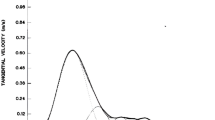Abstract.
Accuracy of movements requires that the central nervous system computes approximate inverse functions of the mechanical functions of limb articulations. In vertebrates, this is known to be achieved within the cerebellar pathways, and also in the cerebral cortex of primates. A cybernetic circuit achieving this computation allows accurate simulation of fast movements of the eye or forearm. It is consistent with anatomy, and with the classical view of the cerebellum as permanently supervised by the inferior olive. The inferior olive detects over- or under-shoots of movements, and the resulting climbing fiber activity corrects ongoing movements, regulates the function of cerebellar cortex and nuclei, and sets the gains of the sensorimotor reactions.
Similar content being viewed by others
Author information
Authors and Affiliations
Additional information
Received: 25 September 1995/Accepted in revised form: 9 May 1996
Rights and permissions
About this article
Cite this article
Darlot, C., Zupan, L., Etard, O. et al. Computation of inverse dynamics for the control of movements. Biol Cybern 75, 173–186 (1996). https://doi.org/10.1007/s004220050285
Issue Date:
DOI: https://doi.org/10.1007/s004220050285




